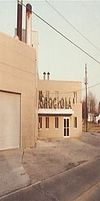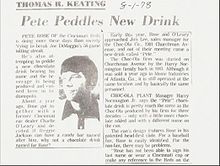- Choc-Ola
-
Choc-Ola Type chocolate beverage Manufacturer BIC, LLC Introduced 1944 Website www.choc-ola.com Choc-Ola is an American chocolate beverage that was formulated in the 1940s by Harry Normington, Sr. from Pennsylvania. Harry, born in England, was the son of Young and Mary Normington. In 1907, his father brought him to the United States, along with the rest of his family, when he was 7 years old. Coming from England on the RMS Lusitania, they arrived[1] like many immigrants of the time through Ellis Island.
The family settled in Lanark, Pennsylvania and started a dairy farm called The Normington Dairy. The Normington Dairy was quite successful and later was renamed Dairyland after it became part of Lehigh Valley Dairy. Lehigh Valley Dairy eventually became Avondale Dairy & Ice Cream.
Harry worked at the dairy until his father's retirement, at which time he purchased his father's shares of stock in Avondale Dairy & Ice Cream.
At the age of 34, Harry established a chain of Avondale ice cream parlors and restaurants in and around the Allentown, PA area and was quite successful for a period of time. However, an extended down-turn in the economy eventually took its toll on his parlors and restaurants and he was forced to close all of his businesses in around 1941.
Afterwards, Harry left Pennsylvania in search of work, and in 1943 he eventually found a job at Meadow Gold Dairy in Vincennes, IN. After moving his family down to Vincennes, he began making plans for a new business in which he planned to bottle and sell a 6 oz chocolate drink; which is what would eventually become Choc-Ola.
His business planning started with visiting nearby big cities to scout out locations for a building suitable for bottling. While he wasn't doing that, he was out acquiring some of the equipment and materials he would later need at the plant, such as motors, wood crates, glass bottles, etc. Much of this would come from junk yards due to the limited supply of materials as a result of WWII.
By 1944, Harry had finally found an adequate building in nearby Indianapolis, which also happened to have a house available right next to it into which he could move his family. The building was located at 2301 Churchman Ave. and the house was at 2323 Churchman Ave.
That same year, after moving his family to Indianapolis and establishing Choc-Ola Bottlers Inc., Harry purchased a route truck and began distributing Choc-Ola throughout central Indiana and eventually to all of Indiana and the bordering areas of Illinois, Kentucky, Ohio and Michigan.
Choc-Ola would eventually gain an enormous and loyal following over the years. But that would all begin to change in the late '70s.
Contents
Choc-Ola sold to Moxie Industries
Choc-Ola continued to gain popularity throughout the '50s, '60s and '70s. In 1977, at the height of its success, Harry sold the company to Moxie Industries. Moxie continued to operate the Indianapolis plant and distribute Choc-Ola in much the same way that Harry Normington had; however, periodic problems with cocoa quality and issues with changing FDA regulations caused some challenging production issues.
Yoo-Hoo purchases Choc-Ola from Moxie
Eventually, in 1985, Moxie decided to sell the Choc-Ola business to The Chocolate Group, which was also the parent company of Yoo-Hoo; one of Choc-Ola's major competitors at the time. Shortly thereafter, The Chocolate Group shut down Choc-Ola's Indianapolis plant and moved the entire bottling operation up to their Yoo-Hoo bottling facility in Carlstadt, NJ.
After the move to Yoo-Hoo's Carlstadt facility, distribution of Choc-Ola was expanded into many other regions of the country, but ironically, distribution was discontinued in central Indiana; its own home turf.
Mott's acquires Choc-Ola
Choc-Ola continued to be manufactured and distributed until Mott's acquired Yoo-Hoo Industries (formerly The Chocolate Group) in the early 2000s. Since Choc-Ola was owned by Yoo-Hoo, it naturally came along as part of the acquisition. Shortly after the Mott's acquisition, Choc-Ola began to be completely phased out.
2010: A New Era Begins
By 2003, Choc-Ola was all but a memory. For years after Mott's ceased production of Choc-Ola there were rumors of it still being available in a small town here and there. But those were most likely just bottles or cans that had been produced prior to the shutdown, but had not yet been consumed.
From 2003 to 2009 Choc-Ola sightings faded into obscurity, while conversely, its fanbase's desire for its return strengthened. Fans constructed message boards[2][3][4] to discuss Choc-ola, they emailed and called the company, and they wondered when, if ever, Choc-Ola would return.
Though its long absence made it unlikely, Choc-Ola would indeed return.
In 2010, a new era for Choc-Ola began. A native Indianapolis man and avid fan of Choc-Ola made it his personal mission to revive Choc-Ola. In early 2010, the owner of the Rock-Cola '50s Cafe in Indianapolis secured the trademark and is manufacturing and selling Choc-Ola out of his authentic 50s-style cafe.
He says that he had plans to bottle and distribute Choc-Ola at some point in the near future. However, for now it can only be obtained by visiting the Rock-Cola Cafe at 5730 Brookville Rd. It is currently available by the glass, or for carry out, you can purchase a gallon jug.
Beginning March 21, 2011 Choc-Ola®, it was announced that an agreement was made with Prairie Farms to produce and distribute Choc-Ola through South Bend, IN-based Martin's Super Markets, a regional 21-store chain. Martin's Super Markets are located throughout northern Indiana and sourthern Michicgan. Martin's will have the exclusive right to sell Choc-Ola® until May 22, 2011. After May 22nd, expect to see new announcements regarding where Choc-Ola® can be purchased.[5]
Prairie Farms plans to begin distributing Choc-Ola in 18 states in individual-sized bottles and half-gallon jugs, primarily at grocery stores and convenience stores. [6]
Nostalgic Memories
In the '70s, as Choc-Ola was gaining a loyal following, it was helped along by advertising spots on local Indiana independent television station, WTTV 4. Choc-Ola's target market at the time was children and young adults, so kid's programs like Cowboy Bob's Corral (aka Cowboy Bob's Chuckwagon Theater) and Nightmare Theater, hosted by Sammy Terry, were regularly utilized as strategic advertising mediums.
"Pete" the Pete Rose Chocolate Drink[7]
Pete Type chocolate beverage Manufacturer Choc-Ola Bottlers Introduced 1978 Discontinued 1979 In the late '70s, Pete Rose was arguably one of the most renowned sports figure of his era. As a member of the Big Red Machine, and nicknamed Charlie Hustle, he was an endorser's dream come true.
In 1978, Rose contacted Choc-Ola[8] in an attempt to partner with them. He liked chocolate beverages and Choc-Ola was one of his favorites. So, together they launched a separate chocolate beverage which would be officially endorsed by Rose called "Pete", figuring that his enormous popularity at the time would make a Rose-endorsed beverage an instant success.
However, what Rose didn't take into account was that, per his contract, he was prohibited from making any unauthorized advertising reference to the Cincinnati Reds, including being shown in his Reds ball cap. This hampered the success of the "Pete" beverage and, although it was actually distributed for a period of time, the short-lived drink was shelved almost as quickly as it was conceived.
The Choc-Ola Cow Mascot
At some point, the Indianapolis plant acquired a mascot of sorts; a giant white and black spotted cow that was raised on a white pole at the south end of the main parking lot. In fact, it was erected on the same site that the Normington house once resided.
For a good portion of the cow's existence, Indianapolis residents could pass by this roadside icon and, if they were very observant, they could see an actual arrow sticking out of the side of the cow facing the street. That arrow, too high to easily reach and remove, stayed there for years. It is not known who shot the cow or exactly when, but the cow never appeared any worse for the wear.
After the plant closed, many wondered what became of the old cow. It is rumored that it was sold to a local used car dealer on the west side of Indianapolis. So it could perhaps still be hanging around yet today.
Key Dates [9]
- 1943: Harry Normington founds Choc-Ola Bottlers, Inc
- 1944: Choc-Ola begins 1st year of production
- 1977: Choc-Ola is acquired by Moxie Industries, Inc.
- 1978: "Pete" chocolate beverage is introduced
- 1982: Mott's is acquired as a separate division of Cadbury-Schweppes (now Cadbury plc)
- 1985: Choc-Ola is acquired by The Chocolate Group, Inc.
- 1989: Choc-Ola trademark is renewed by The Chocolate Group, Inc.
- 1993: The Chocolate Group changes its name to Yoo-Hoo Industries, Inc.
- 2003: Yoo-Hoo Industries is acquired by Mott's, LLP (now a division of Dr Pepper Snapple Group)
- 2008: Choc-Ola remains under the Mott's division as Cadbury-Schweppes North America reorganizes into Dr Pepper/Snapple Group
- 2009: Choc-Ola trademark expires
- 2010: Choc-Ola trademark is acquired by BIC, LLC of Indianapolis, IN
- 2011: Beginning March 21, Choc-Ola® will be available at all (21) store locations of Martin's Super Markets.
References
- ^ "Normingtons arrive at Ellis Island". http://www.ellisisland.org/search/shipManifest.asp?MID=06832721060176838144&LNM=NORMINGTON&PLNM=NORMINGTON&last_kind=0&RF=29&PID=102104100156.
- ^ "Choc-Ola message board 1". http://www.inthe80s.com/food/chocoladrink0.shtml.
- ^ "Choc-Ola message board 2". http://www.belowtopsecret.com/thread202082/pg1.
- ^ "Choc-Ola message board 3". http://www.bevnet.com/bevboard/product-location/28687-choc-ola.html.
- ^ http://www.insideindianabusiness.com/newsitem.asp?id=46860
- ^ http://choc-ola.com/pressReleases/prairieFarms.html
- ^ Source: Pete Rose: a biography; pg 101. http://books.google.com/books?id=dYjWQWvwI0kC&pg=PA101&lpg=PA101&dq=Pete+rose+chocolate+beverage&source=bl&ots=fCq3iuVOGg&sig=82gBFXZICwH1iitpMVS7Zx520Pw&hl=en&ei=0sA9TKqTLM_9nQfn5v3dDg&sa=X&oi=book_result&ct=result&resnum=4&ved=0CCIQ6AEwAw#v=onepage&q&f=false.
- ^ Source: Indianapolis Star 01AUG78 / Article written by Thomas R. Keating
- ^ "Source: United States Patent & Trademark Office". http://tarr.uspto.gov/servlet/tarr?regser=serial&entry=77768627.
External links
Categories:- Chocolate beverages
- American beverages
Wikimedia Foundation. 2010.








